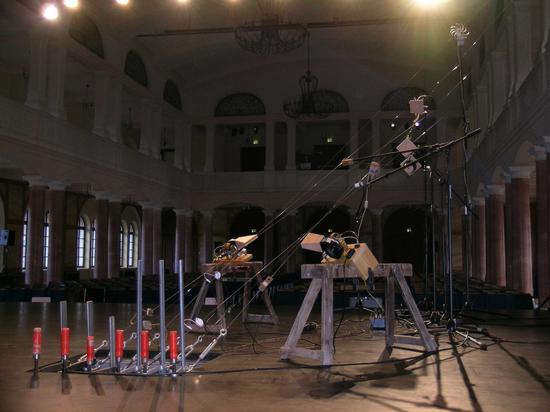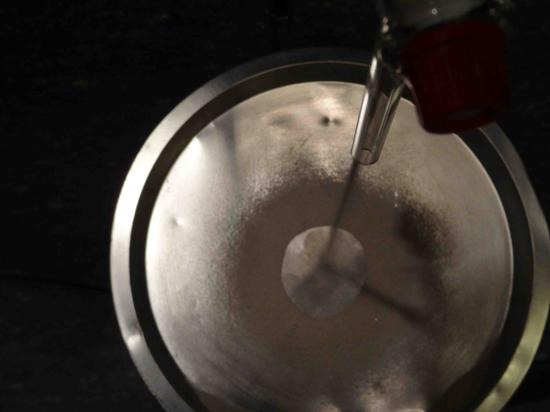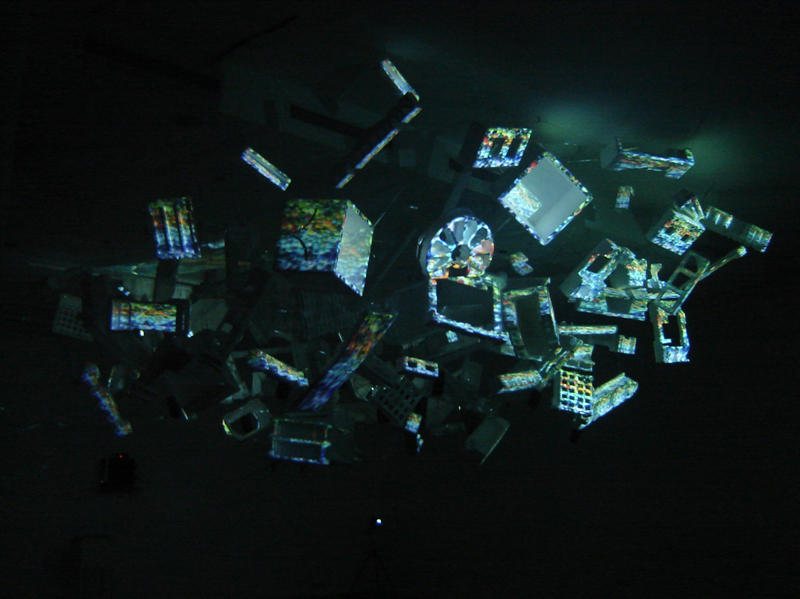Hans Beckers (1986) lives and works in Ghent, where he studied Multimedia Arts at the School of Arts (KASK). His work is mainly focused on sound, installations, music and performances, but he also makes drawings, etchins and compositions for theatre, video and performances.
- Home
- ChampdAction
- Ontwikkeling
- Productie
- Artists in residence
- ChampdAction/LAbO
- Kalender
- ChampdAction/Studio
- Audio & video
- Pers
- Nieuwsbrieven
- Archief
- Coproducenten/partners
- Contact
TIME CANVAS 2012 SCRATCHBOOK
ECOLOGIE - TECHNOLOGIE
VOLKER STAUB

Polychord 2 (Klanginstallation 2008)
Im Jahr 1984 konstruierte ich ein großes kastenförmiges Saiteninstrument, das mit Klavier-Diskantsaiten unterschiedlicher Dicke bespannt wurde. Der frei schwingende Teil der Saiten war 2,20 Meter lang und der Tonumfang betrug eine Duodezime vom Kontra B bis zum kleinen f. Die Saiten waren in reinen Intervallen gestimmt und auf den Resonanzboden war ein Raster gezeichnet, das die Positionen der Obertöne 2 - 16 markierte. Durch leichtes Berühren der Saiten an diesen Punkten und gleichzeitigem Zupfen oder Streichen, konnten die entsprechenden Obertöne zum Klingen gebracht werden. Da einige dieser Obertöne (der. 5., 7., 10., 11., 13., 14. und 15.) nicht unserer gewohnten wohltemperierten Stimmung entsprechen, konnte ich an diesem Instrument eine Vielzahl von neuen Zusammenklängen studieren. In Anlehnung an das Monochord (was so viel heißt, wie „eine Saite“), mit dem Pythagoras schon im 6. Jahrhundert vor Christus den Zusammenhang von Schwingungs- und Zahlenverhältnissen erforschte, nannte ich mein Instrument Polychord.
Heute interessieren mich an den Klängen von Saiten eher die komplexeren Phänomene, die sich der genauen Beschreibung entziehen. Es handelt sich einerseits um die so genannte Longitudinalschwingung, eine Schwingung, die auf der Saite wellenförmig hin- und herwandert. Andererseits sind es dichte Aggregate komplexer Obertongemische, die sich fortwährend und kontinuierlich verändern, wenn sie einmal angeregt wurden. Zur Erzeugung dieser Klänge sind recht lange und dünne Saiten notwendig. Die Installation „Polychord 2“ erfüllt diese Anforderungen. Die Tonerzeugung erfolgt nicht von Menschhand sondern mechanisch durch regelbare Gebläse und durch sehr langsam rotierende Elektromotoren, die verschiedene Materialien gegen die Saiten reiben, streichen und schlagen lassen.
Die Installation „Polychord 2“ befindet so gesehen in der Tradition der mechanischen Musikinstrumente, die z. B. im 18. und 19. Jahrhundert zur Reproduktion von Musik verwendet wurden. Flötenuhr, Player Piano und Orchestrion waren Vertreter dieser instrumentalen Gattung, die Anfang des 20. Jahrhunderts von der sehr viel einfacheren und billigeren Technologie des Grammophons verdrängt wurde.
Aus dem Blickwinkel der heutigen Zeit besitzt die mechanische Klangerzeugung allerdings Möglichkeiten, die jenseits der Fertigkeiten menschlicher Musiker und Wiedergabetechnik liegen. Hierzu zählen z. B. extremes Spieltempo, extreme Langsamkeit, extreme rhythmische Präzision und Komplexität oder das Auslösen chaotischer Klangformen durch die mechanische Anregung langer Saiten bei der Installation Polychord 2.
Sept. 2012 - Volker Staub
******************************************
JAIME E. OLIVER
Jaime E. Oliver (Lima, 1979) is currently a Mellon Post-Doctoral Fellow in composition at Columbia University in New York. He obtained a PhD in Computer Music from the University of California, San Diego (2011) where he studied with Miller Puckette.
Oliver’s music and research explores the concept of musical instrument in electronic and computer music, designing instruments that listen, understand, remember and respond. His open source Silent Drum and MANO controllers use computer vision techniques to continuously track and classify hand gestures.
VIVO
Interactive Audiovisual Installation by: Jaime Oliver, Mauricio Delfin, José Aburto and Fátima Rodrigo.
*********************************************
JOHANNES KREIDLER
Johannes Kreidler (1980) studied from 2000 to 2006 at the Musikhochschule in Freiburg, Germany where teachers included Mathias Spahlinger (composition), Mesias Maiguashca and Orm Finnendahl (electronic music), and Ekkehard Kiem (music theory). During this time he was also a Fellow of the European Union from 2004 to 2005 and a visiting student at the Institute of Sonology at the Koninklijk Conservatorium at The Hague in the Netherlands. He also attended seminars in philosophy and art history at the University of Freiburg. In 2008 he received broad attention for an art performance action in which he delivered 70,200 forms by truck to the GEMA head office (the German performance rights authority) in order to officially register his recent 33-second electronic piece comprised of 70,200 samples of other artists' work.
Since 2006 he has taught music theory, ear training, and electronic music in Germany at the Hochschule für Musik und Theater in Rostock, in the advanced training division of the Musikhoch-schule Detmold, and, since 2009, at the Hochschule für Musik und Theater in Hannover.
Kreidler's works have been featured at numerous international music festivals, including the Donaueschingen and Darmstadt festivals, Ultima Festival Oslo, Musica Strasbourg, Gaudeamus Music Week, and the Huddersfield Contemporary Music Festival.
Johannes Kreidler lives in Berlin. His music usually employs computer-assisted processes and electroacoustic elements.
Charts Music (2009)
music with visualization
Duration: 3'
Melodies derived from Stock Charts, arranged with Microsoft Songsmith.

New Technology and the Music it creates (2011)

*******************************************************
HANS BECKERS
Voor deze voorstelling werd een orkest geconstrueerd met als solisten onder meer eiersnijders, ijscoupes, zeven en papaverbollen. Elk instrument wordt afzonderlijk aangedreven door een relais uit een oude telefooncentrale en kan worden gezien als een medemuzikant met elk een eigen inbreng en vorm van improvisatie.



******************************************************
GODFRIED-WILLEM RAES
http://logosfoundation.org/mnm/media.html
Godfried-Willem Raes, born in Gent (Europe) in 1952, is known worldwide as a 'musicmaker' in the largest sense of the word: as a concert-organizer he's been responsible from 1973 until 1988 for the new-music concert programming of the Philharmonic Society at the Palais des Beaux Arts in Brussels, in addition to which he also organized and still organizes all the concerts which take place at the Logos Foundation in Gent, in total about 150 international new music concerts a year. Over a timespan of almost 45 years he turned the Logos Foundation into the most active new music organization in Belgium. As a composer/performer and instrumentmaker he is the founder of the Logos- Group (1968), out of which grew the Logos Duo, with Moniek Darge as well as the well known experimental <M&M> (Man and Machine) orchestra, operating with his spectacular musical robots.
Godfried-Willem Raes studied musicology and philosophy at the Ghent State University as well as piano, clarinet, percussion and composition at the Royal Conservatory of Music of Gent.
He has also published a great number of critical essays and articles in specialized publications. In 1982 he received the Louis Paul Boon Award for the social engagement in his artistic work. In 1988 he became a professor of music composition at the Ghent Royal Conservatory. In 1997 he also became a professor at the Orpheus Higher Institute for Music, a commitment he held, up to 2009. In 1990 he designed and constructed a tetrahedron-shaped concert-hall for the Logos Foundation in Ghent, a project for which it received the Tech-Art prize 1990.
Next to his reputation as a composer, he is also a well known expert in computer technology, robotics and interactive electronic art. He holds a doctors degree from Ghent State University on the basis of his dissertation on the technology of virtual instruments of his design and invention. He is the author of an extensive real time algorithmic music composition programming language: <GMT> running on the Wintel platform.
He is currently the president of the Logos Foundation and general director of the Logos M&M ensemble as well as a full time research professor at the Ghent University Association, School of Arts.
************************************************************
WARD WEIS
http://www.planktone.net/
Het radiowerk van Ward Weis is gekenmerkt door een zoektocht naar de grenzen van “het geluid”. Wanneer wordt een reëel geluid als een abstracte klank ervaren? Kunnen we de herkenbaarheid loslaten en ons openstellen voor de tonaliteit die ons dagelijks omringt. Ward Weis gunt ons graag een oor in zijn klankwereld.
Durven we luisteren? Het is een luistersessie voor durvende oren. Luisteren in ruimte en tijd. Luisteren naar tijd en ruimte. Kijken in klanken naar de virtuele einder. Het is aanbevolen er zelf voor te zorgen comfortabel te kunnen luisteren. Een kussen, matrasje, strandstoel, … kan helpen.
Ward Weis born, antwerp ’56, studied movie making, brussels. Works as sound-engineer for VRT ( flemisch national radio & television ) in the drama department. Lectured radio-art at the national radio & film school, brussels, co-operated with different workshops
Made several tapes for radio, television, film, theatre, museums.
Info: http://www.impactsessions.be/performers/33/ward-weis
************************************************************
KATHLEEN COESSENS & ANN EYSERMANS
Kathleen Coessens, doctor in de wijsbegeerte, studeerde filosofie, sociologie en psychologie aan de VUB, Muziek (Hoger diploma piano en kamermuziek) aan het Koninklijk Conservatorium Brussel en de Ecole Cortot te Parijs. In verderzetting van haar doctoraat in de filosofie 'De mens als cartograaf - Omgaan met de reeds in kennis gebrachte wereld', onderzoekt zij de relaties tussen wetenschap en kunst, menselijke creativiteit en culturele representaties, vanuit een belichaamd, epistemologisch en filosofisch standpunt. Aan de VUB doceert zij sinds enkele jaren het vak 'Communicatiemethoden III: Inhoudsanalyse en semiotiek'. Zij werkt als senior researcher voor het Orpheus Instituut in Gent in het domein van onderzoek in de kunsten, en is gastprofessor aan het Conservatorium te Antwerpen waar zij 'sociologie van de artistieke praktijk' evenals 'vakoverschrijdend cultuurkader' doceert. Een recente publicatie is 'The Artistic Turn - a manifesto' samen met Anne Douglas and Darla Crispin (2009).
Info: http://www.vub.ac.be/SCOM/team/andere_proffen.htm
http://kathleencoessens.cgpublisher.com/
http://www.anneysermans.be
SOUNDING CARTOGRAMS
zichtbare onzichtbare sporen van stedelijke trajecten
Sounding cartograms brengt onzichtbare lagen van stedelijke ecologie artistiek in kaart. Trein en riolering zijn sporen van menselijke aanwezigheid. De stadsbewoner is zich vaak niet bewust van de permanente zichtbare, hoorbare, ruikbare, tastbare aanwezigheid van beide sporen. Roestende treinen, zuchtende locomotieven, vochtige coupés vullen een netwerk van ijzer. Borrelende afvoerputten, voortstuwend afvalwater, zwoele geuren kruisen in het ondergrondse. Ann Eysermans onderzoekt artistiek de verschillende lagen van treinnetwerken en herleidt deze tot een cartografisch skelet dat de basis vormt voor een grafische partituur. Kathleen Coessens volgt de loop van stedelijk afvalwater en afvoerputten en construeert een zintuiglijke cartografie van de riolering. Hoe al deze sensaties en artistieke transformaties overbrengen naar het medium van de muziek? Beide zoektochten kruisen elkaar in Sounding Cartograms, een intermediale installatie en performance. ((Een multimediale publicatie traceert het hele artistieke proces))
© 2004-2024 ChampdAction

